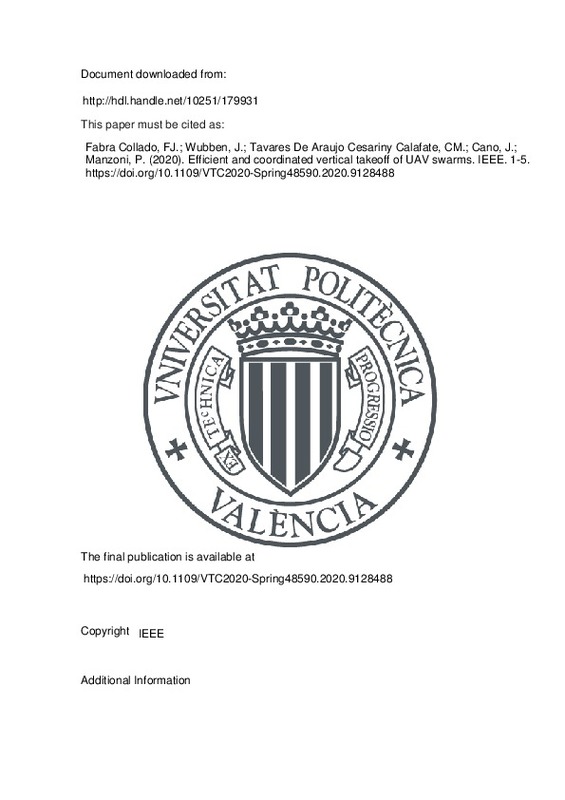JavaScript is disabled for your browser. Some features of this site may not work without it.
Buscar en RiuNet
Listar
Mi cuenta
Estadísticas
Ayuda RiuNet
Admin. UPV
Efficient and coordinated vertical takeoff of UAV swarms
Mostrar el registro sencillo del ítem
Ficheros en el ítem
| dc.contributor.author | Fabra Collado, Francisco José
|
es_ES |
| dc.contributor.author | Wubben, Jamie
|
es_ES |
| dc.contributor.author | Tavares De Araujo Cesariny Calafate, Carlos Miguel
|
es_ES |
| dc.contributor.author | Cano, Juan-Carlos
|
es_ES |
| dc.contributor.author | Manzoni, Pietro
|
es_ES |
| dc.date.accessioned | 2022-01-19T09:17:37Z | |
| dc.date.available | 2022-01-19T09:17:37Z | |
| dc.date.issued | 2020-05-28 | es_ES |
| dc.identifier.isbn | 978-1-7281-5207-3 | es_ES |
| dc.identifier.uri | http://hdl.handle.net/10251/179931 | |
| dc.description.abstract | [EN] As we witness the unrelenting growth of the UAV sector, novel and more sophisticated applications keep emerging every year, with many more in the horizon. Among these, applications that require the adoption of UAV swarms are among the most complex, as deploying swarms requires the interaction and cooperation of all the UAVs involved, which can become quite challenging. In this work we specifically focus on the swarm takeoff procedure for UAVs of the Vertical Take-Off and Landing (VTOL) type, proposing a heuristic that achieves reduced computing overhead while introducing near-optimal assignments of UAV positions in the swarm formation selected. Such heuristic is complemented by an efficient and collision-free takeoff approach that relies on adequate ordering and inter- UAV communications to achieve a sequential phased takeoff. A large number of experiments using our own ArduSim emulation platform, which is totally compatible with real drone code, evidence the improvements achieved in terms of time overhead and safety when compared to both ideal and agnostic approaches. | es_ES |
| dc.description.sponsorship | This work was partially supported by the Ministerio de Ciencia, Innovacion y Universidades, Programa Estatal de Investigacion, Desarrollo e Innovacion Orientada a los Retos de la Sociedad, Proyectos I+D+I 2018, Spain, under Grant RTI2018-096384-B-I00. | es_ES |
| dc.language | Inglés | es_ES |
| dc.publisher | IEEE | es_ES |
| dc.relation.ispartof | 2020 IEEE 91st Vehicular Technology Conference, VTC2020-Spring | es_ES |
| dc.rights | Reserva de todos los derechos | es_ES |
| dc.subject | UAV | es_ES |
| dc.subject | Swarm | es_ES |
| dc.subject | Safe takeoff | es_ES |
| dc.subject | Flight coordination | es_ES |
| dc.subject.classification | ARQUITECTURA Y TECNOLOGIA DE COMPUTADORES | es_ES |
| dc.title | Efficient and coordinated vertical takeoff of UAV swarms | es_ES |
| dc.type | Comunicación en congreso | es_ES |
| dc.type | Capítulo de libro | es_ES |
| dc.identifier.doi | 10.1109/VTC2020-Spring48590.2020.9128488 | es_ES |
| dc.relation.projectID | info:eu-repo/grantAgreement/AEI/Plan Estatal de Investigación Científica y Técnica y de Innovación 2017-2020/RTI2018-096384-B-I00/ES/SOLUCIONES PARA UNA GESTION EFICIENTE DEL TRAFICO VEHICULAR BASADAS EN SISTEMAS Y SERVICIOS EN RED/ | es_ES |
| dc.rights.accessRights | Abierto | es_ES |
| dc.contributor.affiliation | Universitat Politècnica de València. Departamento de Informática de Sistemas y Computadores - Departament d'Informàtica de Sistemes i Computadors | es_ES |
| dc.description.bibliographicCitation | Fabra Collado, FJ.; Wubben, J.; Tavares De Araujo Cesariny Calafate, CM.; Cano, J.; Manzoni, P. (2020). Efficient and coordinated vertical takeoff of UAV swarms. IEEE. 1-5. https://doi.org/10.1109/VTC2020-Spring48590.2020.9128488 | es_ES |
| dc.description.accrualMethod | S | es_ES |
| dc.relation.conferencename | 91st IEEE Vehicular Technology Conference (VTC2020-Spring) | es_ES |
| dc.relation.conferencedate | Mayo 25-28,2020 | es_ES |
| dc.relation.conferenceplace | Online | es_ES |
| dc.relation.publisherversion | https://doi.org/10.1109/VTC2020-Spring48590.2020.9128488 | es_ES |
| dc.description.upvformatpinicio | 1 | es_ES |
| dc.description.upvformatpfin | 5 | es_ES |
| dc.type.version | info:eu-repo/semantics/publishedVersion | es_ES |
| dc.relation.pasarela | S\413249 | es_ES |







![[Cerrado]](/themes/UPV/images/candado.png)

